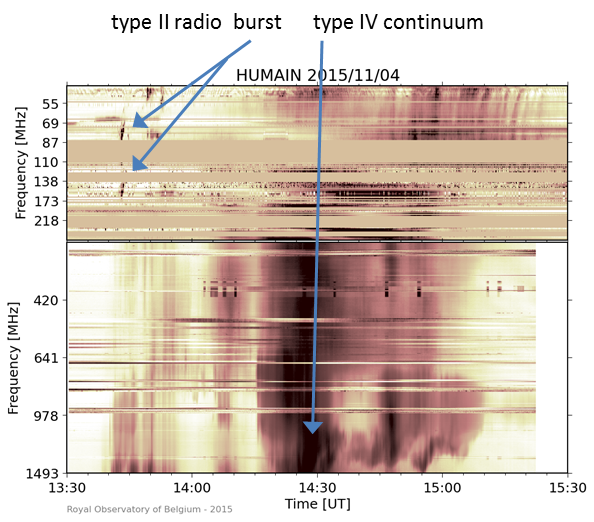This news item was written by Dr Jasmina Magdalenic, scientist at the Royal Observatory of Belgium.
Although we are already in the declining phase of this solar cycle, the Sun was rather busy on 04 November. Three rather large eruptive phenomena (M-class flares) were observed on that day. The two smaller eruptions (i.e. M1.9 and M2.5) originated from active region NOAA 2445, while the largest one, the M3.7 flare, originated from the active region NOAA 2443 which was near disk centre at the time of the eruption. The GOES curves in the figure underneath show several solar flares recorded on 04 November. The most prominent ones were the three medium-sized M-class flares (with the maximum intensities above the pink horizontal line). All three events were associated with radio emission, but the most complex radio emission was linked to the long duration M3.7 flare.

The HUMAIN Solar Radio Spectrograph (HSRS) recorded the intense radio emission (in association with the long duration M3.7 flare), consisting of a so-called type II radio burst and strong type IV radio continuum (figure underneath). The radio spectrogram or dynamic spectrum (recorded by HSRS) is a graphical presentation of the radio emission intensity, recorded at a number of closely spaced frequencies. In the spectrograms, the horizontal x-axis represents time increasing from left to the right and the vertical y-axis represents frequency. Two different types of radio emission can be seen in the spectrogram underneath (darker color indicates more intense radio emission).

A type II burst is commonly defined as a radio signature of the shock wave, usually generated by the large eruptions of plasma confined in erupting magnetic flux ropes, so called coronal mass ejection.
The type IV continuum emission, like the one which covered the full range of HSRS observations on 04 November (figure above), is generally associated with solar flares. Since the majority of the radio observations do not estimate the real strength of the radio emission (in solar flux units), we can only guess on the intensity of the observed radio emission.
The HSRS observations are unique radio observations in Europe, covering a rather large frequency range, which offers the real time information about the ongoing radio activity, but they also do not provide information on the exact strength of the radio emission.
The problems of the Swedish air traffic control (radars stopped showing airplanes) reported on 04 November, lasted about an hour starting from around 13:30UT. These phenomena temporarily coincided with the start of the intense radio emission observed by HSRS (see figure above).
Therefore we can deduce that the apparently strong type IV radio emission which was observed on both GPS frequencies (around 1.5 GHz) and the civil air traffic control communication channels (about 120-140 MHz), might have been the source of the radio blackout experienced by the Swedish air traffic control.

The animation above combines SDO/AIA 171 & 304 imagery (extreme ultraviolet) of NOAA 2443 on 04 November between 13:00 and 18:00UT.
 |
 |





